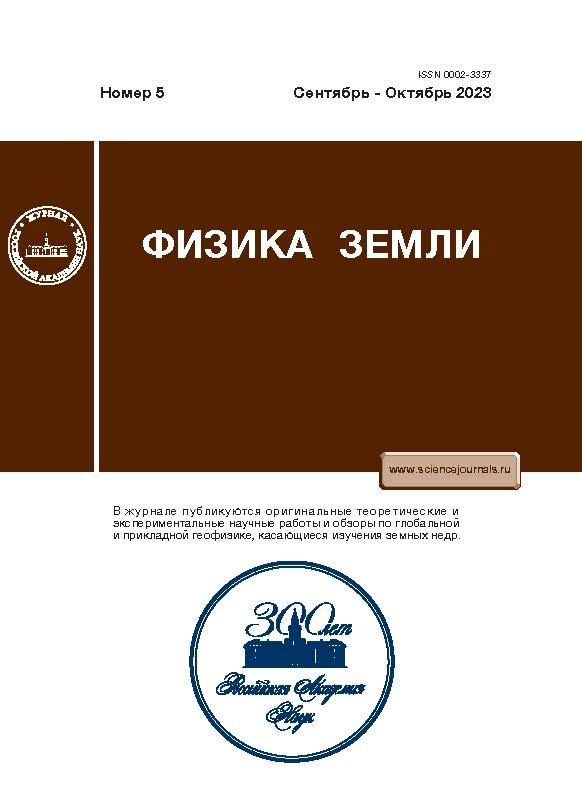Theory of Anhysteretic Remanent Magnetization of Single-Domain Grains
- Authors: Shcherbakov V.P.1, Sycheva N.K.1
-
Affiliations:
- Borok Geophysical Observatory, Schmidt Institute of Physics of the Earth
- Issue: No 5 (2023)
- Pages: 3-12
- Section: Articles
- URL: https://journals.rcsi.science/0002-3337/article/view/139037
- DOI: https://doi.org/10.31857/S0002333723050095
- EDN: https://elibrary.ru/VZWAMH
- ID: 139037
Cite item
Abstract
Abstract—A new approach to the solution of kinetic equations describing the process of formation of anhysteretic remanent magnetization (ARM) is proposed, which made it possible to accelerate the numerical calculation of the process of formation of ARM by two orders of magnitude for uniaxial oriented non-interacting single-domain particles, while practically not yielding in accuracy to a strict numerical solution. It follows from the calculation results that the susceptibility of ARM is entirely determined by the magnitude of the particle’s coercivity parameter. The data of the previous approximate calculations of ARM value are compared with the exact results presented here and it is shown that the discrepancy between the exact data and the approximate estimates increases with the growth of g, but remains relatively small, within 23%. The proposed algorithm for the rapid calculation of kinetic equations allows us to analyze with physical rigor the method of pseudo-Thellier estimation of paleointensivity for an ensemble of single-domain particles, which is supposed to be done in subsequent works.
About the authors
V. P. Shcherbakov
Borok Geophysical Observatory, Schmidt Institute of Physics of the Earth
Author for correspondence.
Email: shcherbakovv@list.ru
Russia, 152742, Yaroslavl Region, , Borok
N. K. Sycheva
Borok Geophysical Observatory, Schmidt Institute of Physics of the Earth
Author for correspondence.
Email: sycheva@borok.yar.ru
Russia, 152742, Yaroslavl Region, , Borok
References
- Борисова Г.П., Шолпо Л.Е. О возможности статистических оценок палеонапряженности геомагнитного поля // Изв. АН СССР. Сер. Физика Земли. 1985. № 7. С. 71–79.
- Грибов С.К., Щербаков В.П., Цельмович В.А., Афиногенова Н.А. Свойства термохимической остаточной намагниченности, образованной при медленном лабораторном охлаждении титаномагнетитсодержащих базальтовых образцов от различных температур, и результаты применения к ней методики Телье // Физика Земли. 2021. № 6. С. 107–121. https://doi.org/10.31857/S0002333721060016
- Нагата Т. Магнетизм горных пород. М.: Мир. 1965. 348 с.
- Щербаков В.П., Грибов С.К., Афиногенова Н.А., Цельмович В.А. Однофазное окисление ферримагнитных зерен как причина L-образной формы диаграмм Араи–Нагата // Физика Земли. 2020. № 5. С. 70–80. https://doi.org/10.31857/S0002333720050105
- Щербаков В.П., Щербакова В.В. О магнитостатическом взаимодействии в системе однодоменных зерен // Изв. АН СССР. Сер. Физика Земли. 1975. № 9.
- Щербаков В.П., Щербакова В.В. К расчету термоостаточной и идеальной намагниченностей ансамбля взаимодействующих однодоменных зерен // Изв. АН СССР. Сер. Физика Земли. 1977. № 6. С. 69–83.
- Brown W.F. Thermal fluctuation of a single-domain particle // Phys. Rev. 1963. V. 130. P. 1677–1686.
- de Groot L.V., Biggin A.J., Dekkers M.J., Langereis C.G., Herrero-Bervera E. Rapid regional perturbations to the recent global geomagnetic decay revealed by a new Hawaiian record // Nat. Commun. 2013. V. 4. https://doi.org/10.1038/ncomms3727
- de Groot L.V., Dekkers M.J., Visscher M., ter Maat G.W. Magnetic properties and paleointensities as function of depth in a Hawaiian lava flow // Geochem. Geophys. Geosyst. 2014. V. 15. P. 1096–1112.
- de Groot L.V. et al. High paleointensities for the Canary Islands constrain the Levant geomagnetic high // Earth planet. Sci. Lett. 2015. V. 419. P. 154–167.
- de Groot L.V., Pimentel A., Di Chiara A. The multi-method paleointensity approach applied to volcanics from Terceira: full-vector geomagnetic data for the past 50 kyr // Geophys. J. Int. 2016. V. 206(1). P. 590–604.
- Dunlop D., Ozdemir O. Rock magnetism. Fundamentals and frontiers. Cambridge University Press. 1997. 573 p.
- Egli R., Lowrie W. Anhysteretic remanent magnetization of fine magnetic particles // Journal of Geophysical Research. 2002. V. 107. № B10. P. 2209, https://doi.org/10.1029/2001JB000671
- Jaep W.F. Anhysteretic magnetization of an assembly of single-domain Particles // J. Appl. Phys. 1969. V. 40. P. 1297– 1298.
- Néel L. Some theoretical aspects of rock-magnetism // Advances in Physics. 1955. V. 4(14). P. 191–243. https://doi.org/10.1080/00018735500101204
- Paterson G.A., Heslop D., Yongxin P. The pseudo-Thellier palaeointensity method: new calibration and uncertainty estimates // Geophys. J. Int. 2016. V. 207. P. 1596–1608. https://doi.org/10.1093/gji/ggw349
- Shaw J. A new method of determining the magnitude of the paleomagnetic field // Geophys. J. R. Astron. Soc. 1974. V. 39. P. 133–141.
- Shcherbakov V.P., Lhuillier F., Sycheva N.K. Exact Analytical Solutions for Kinetic Equations Describing Thermochemical Remanence Acquisition for Single-Domain Grains: Implications for Absolute Paleointensity Determinations // JGR Solid Earth. 2021. V. 126. № 5. P. 1–24. https://doi.org/10.1029/2020JB021536
- Stacey F.D., Banerjee S.K. The physical principles of the rock magnetism. Elsevier, Amsterdam. 1974. 195 p.
- Sugiura N. ARM, TRM, and magnetic interactions: concentration dependence // Earth Planet. Sci. Lett. 1979. V. 42. P. 451–455.
- Tauxe L., Pick T., Kok Y.S. Relative paleointensity in sediments: A pseudo-Thellier approach // Geophys. Res. Lett. 1995. V. 22. P. 2885–2888.
- Victora R.H. Predicted time dependence of the switching field for magnetic materials // Phys. Rev. Lett. 1989. V. 63. P. 457–460.
- Walton D. A theory of anhysteretic remanent magnetization of singledomain grains // J. Magn. Magn. Mater. 1990. V. 87. P. 369–374.
- Wohlfarth E.P. A review of the problem of fine-particle interactions with special reference to magnetic recording // J. Appl. Phys. 1964. V. 35. P. 783–790.
Supplementary files















